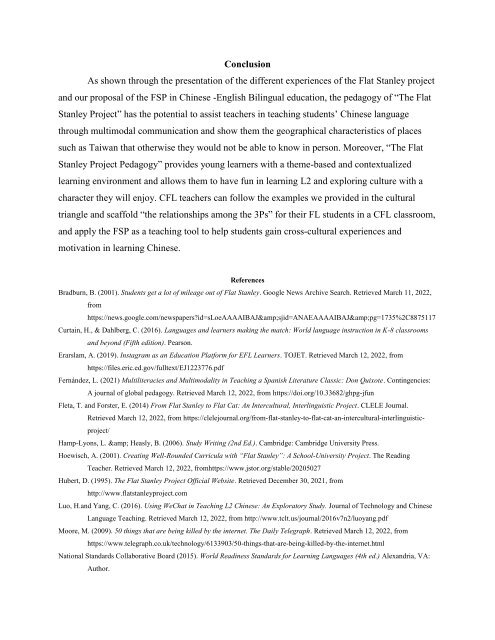K-12 Chinese Language Teaching, Issue 5
The K-12 CLT focuses on sharing experiences and exchanging ideas in teaching, research, and professional development.
The K-12 CLT focuses on sharing experiences and exchanging ideas in teaching, research, and professional development.
Create successful ePaper yourself
Turn your PDF publications into a flip-book with our unique Google optimized e-Paper software.
Conclusion<br />
As shown through the presentation of the different experiences of the Flat Stanley project<br />
and our proposal of the FSP in <strong>Chinese</strong> -English Bilingual education, the pedagogy of “The Flat<br />
Stanley Project” has the potential to assist teachers in teaching students’ <strong>Chinese</strong> language<br />
through multimodal communication and show them the geographical characteristics of places<br />
such as Taiwan that otherwise they would not be able to know in person. Moreover, “The Flat<br />
Stanley Project Pedagogy” provides young learners with a theme-based and contextualized<br />
learning environment and allows them to have fun in learning L2 and exploring culture with a<br />
character they will enjoy. CFL teachers can follow the examples we provided in the cultural<br />
triangle and scaffold “the relationships among the 3Ps” for their FL students in a CFL classroom,<br />
and apply the FSP as a teaching tool to help students gain cross-cultural experiences and<br />
motivation in learning <strong>Chinese</strong>.<br />
References<br />
Bradburn, B. (2001). Students get a lot of mileage out of Flat Stanley. Google News Archive Search. Retrieved March 11, 2022,<br />
from<br />
https://news.google.com/newspapers?id=sLoeAAAAIBAJ&sjid=ANAEAAAAIBAJ&pg=1735%2C8875117<br />
Curtain, H., & Dahlberg, C. (2016). <strong>Language</strong>s and learners making the match: World language instruction in K-8 classrooms<br />
and beyond (Fifth edition). Pearson.<br />
Erarslam, A. (2019). Instagram as an Education Platform for EFL Learners. TOJET. Retrieved March <strong>12</strong>, 2022, from<br />
https://files.eric.ed.gov/fulltext/EJ<strong>12</strong>23776.pdf<br />
Fernández, L. (2021) Multiliteracies and Multimodality in <strong>Teaching</strong> a Spanish Literature Classic: Don Quixote. Contingencies:<br />
A journal of global pedagogy. Retrieved March <strong>12</strong>, 2022, from https://doi.org/10.33682/ghpg-jfun<br />
Fleta, T. and Forster, E. (2014) From Flat Stanley to Flat Cat: An Intercultural, Interlinguistic Project. CLELE Journal.<br />
Retrieved March <strong>12</strong>, 2022, from https://clelejournal.org/from-flat-stanley-to-flat-cat-an-intercultural-interlinguisticproject/<br />
Hamp-Lyons, L. & Heasly, B. (2006). Study Writing (2nd Ed.). Cambridge: Cambridge University Press.<br />
Hoewisch, A. (2001). Creating Well-Rounded Curricula with “Flat Stanley”: A School-University Project. The Reading<br />
Teacher. Retrieved March <strong>12</strong>, 2022, fromhttps://www.jstor.org/stable/20205027<br />
Hubert, D. (1995). The Flat Stanley Project Official Website. Retrieved December 30, 2021, from<br />
http://www.flatstanleyproject.com<br />
Luo, H.and Yang, C. (2016). Using WeChat in <strong>Teaching</strong> L2 <strong>Chinese</strong>: An Exploratory Study. Journal of Technology and <strong>Chinese</strong><br />
<strong>Language</strong> <strong>Teaching</strong>. Retrieved March <strong>12</strong>, 2022, from http://www.tclt.us/journal/2016v7n2/luoyang.pdf<br />
Moore, M. (2009). 50 things that are being killed by the internet. The Daily Telegraph. Retrieved March <strong>12</strong>, 2022, from<br />
https://www.telegraph.co.uk/technology/6133903/50-things-that-are-being-killed-by-the-internet.html<br />
National Standards Collaborative Board (2015). World Readiness Standards for Learning <strong>Language</strong>s (4th ed.) Alexandria, VA:<br />
Author.


